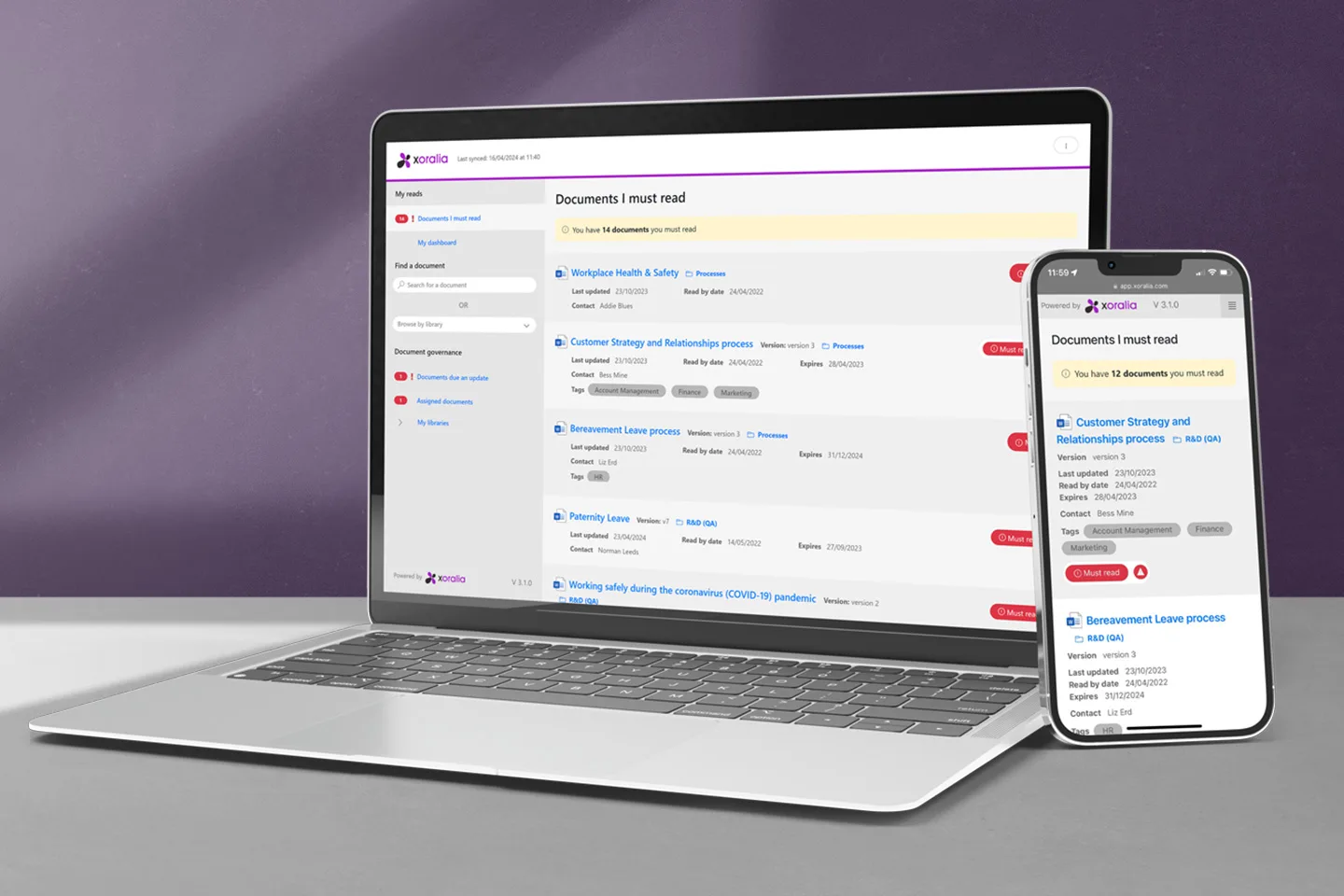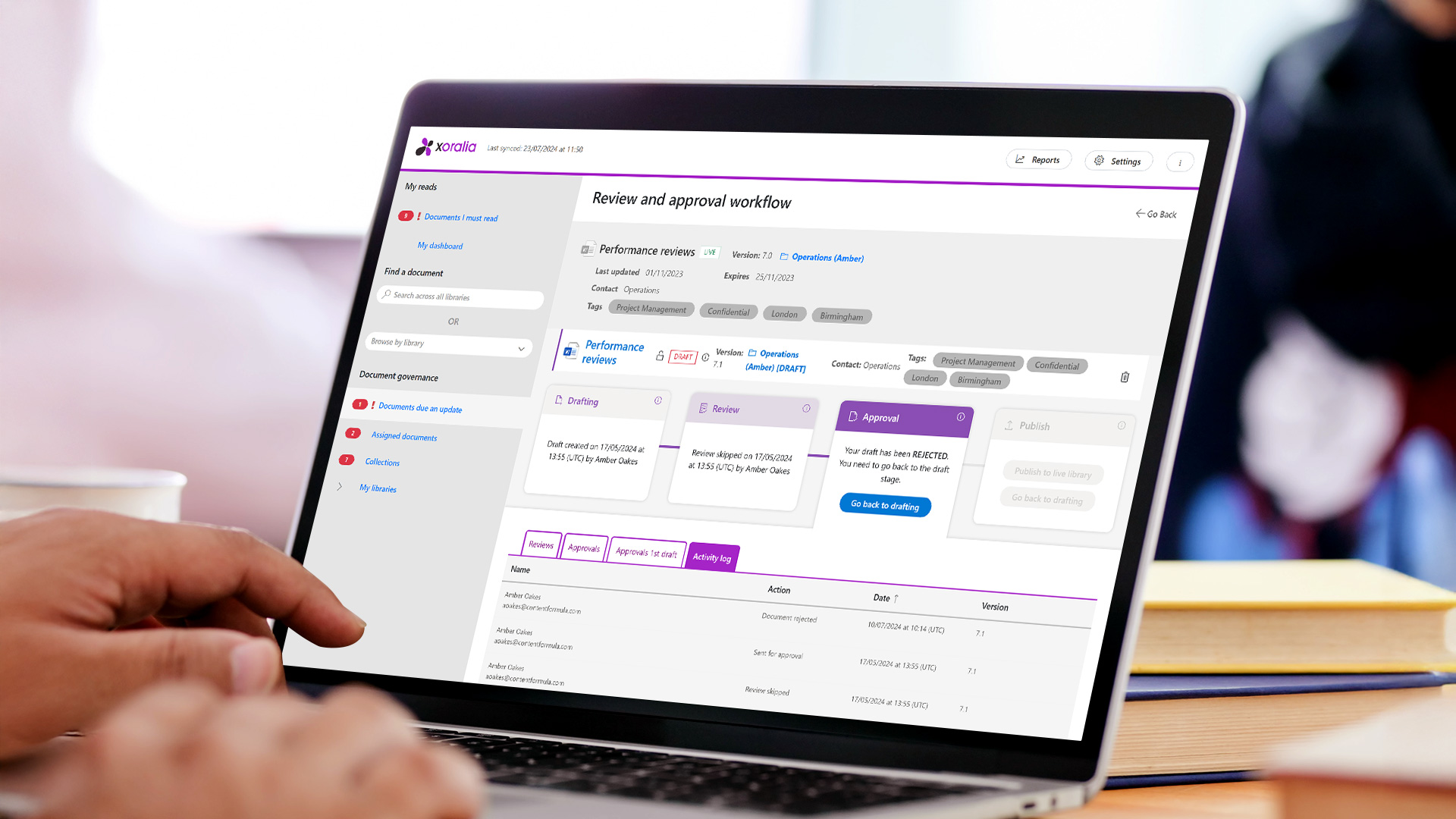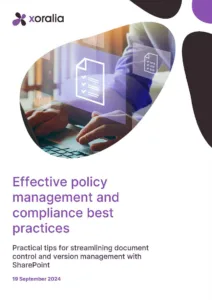Policies and procedure in the workplace: The ultimate guide
- Dan Hawtrey

Policies and procedures are essential tools for any workplace, providing a framework for operations and ensuring compliance with legal and regulatory standards. They help establish clear expectations for behaviour and performance, thereby promoting a culture of accountability and consistency. Effective policy management includes drafting comprehensive policies, reviewing them regularly, and ensuring they are easily accessible to all employees. This approach helps mitigate risks, improve decision-making, and maintain organisational integrity.
In this post, we’re going to do a deep dive into the world of policies and procedures, looking at what they are, why they are important and how to manage them. We’re not expecting you to love policies and procedures, but we hope by the end of the article you’ll view them a little more positively!
What are policies and procedures?
Policies and procedures are structured sets of principles and rules that provide guidance and standardisation for processes across an organisation. They are usually created and presented in document format and act as an important point of reference to guide decision-making.
What is the difference between policies and procedures?
Policies generally outline the key principles and expectations that guide behaviour and decision-making within a company. In contrast, procedures offer detailed instructions on how to carry out specific tasks or actions. While policies tend to remain consistent, procedures may evolve more frequently as operational needs change. Although they are distinct, the line between policies and procedures is often blurred.

Why are policies and procedures are important in the workplace?
Policies and procedures are essential for guiding behaviour, standardising processes, and ensuring compliance within the workplace.
Here are some of the key reasons why policies and procedures play a crucial role in maintaining an efficient and compliant work environment:
Helping employees complete tasks and get things done
In any given working day, employees complete multiple tasks, some relating to their role and others to more general processes. Additionally, employees may have to make several decisions during the working week. Policies and procedures provide essential baseline information for employees to get things done and make accompanying decisions.
Standardising processes
Most organisations seek to standardise processes across different divisions, regions and locations in order to drive efficiency, support customer experience, raise standards and provide consistency and simplicity across complex structures and diverse workforces. Having well-defined policies and procedures underpins this standardisation.
Supporting professional conduct
Policies and procedures define expected levels of professional conduct and behaviour, covering multiple aspects of organisational life including treatment of colleagues, interaction with customers, risk management and more. Having these policies and procedures is important for the smooth day-to-day running of any business.
Supporting compliance and certification
There are a range of different policies and procedures that must be followed for regulatory, legal and compliance reasons. Businesses need to enforce these policies, and may also need to show external regulators and other bodies they are doing everything they can to make sure they are followed. The way policies and procedures are managed and disseminated is a major component of this. Similarly, organisations may have to adhere to standards such as ISO 27001, ISO 9001 and demonstrate policies are being followed to the relevant certification body.
Minimising risks
It’s not just legal and regulatory compliance that is important – having the right policies and procedures helps minimise risks across other areas, such as:
- Health and safety: ensuring the wellbeing of employees and third parties, especially in areas such as construction, engineering, manufacturing and mining
- Brand reputation: helping to preserve business image by supporting good customer service, preventing legal action, ensuring there aren’t data breaches and more
- Supporting employees: ensuring employees follow the correct procedures to limit their personal risk and liability
- And many more!
Helping new starters
It can be an overwhelming and even confusing time when a person starts at a new company, with a lot to do and learn. Having clear policies and procedures helps new starters complete onboarding processes and settle in more quickly; in turn, a positive onboarding experience also reduces employee turnover.
Managing change
Organisations are in a constant state of flux, and managing change across the workforce can be hard. Having clear policies and procedures helps change management and outline new ways of working, both large and small.
Support values and wellbeing
Values and employee wellbeing are increasingly being recognised as important components of employee experience. Ensuring policies and procedures align with company values and provide safeguards for wellbeing can make a tangible difference.
Supporting an employee value proposition
The employee value proposition (EVP) of a company spells out some of its key HR policies and procedures, such as opportunities for career progression, learning and training, flexible working, maternity and paternity leave, pay and benefits and so on. The EVP of an organisation is central to attracting and retaining talent.
Facilitating continuous improvement
Policies and procedures provide a foundation for identifying areas of improvement within the organisation. Regular reviews and updates ensure that processes evolve with changing business needs and industry standards.
Common policies and procedures that every workplace needs

What are some of the common policies and procedures found in the typical workplace? Here are some of the most widespread, and most important.
General conduct
Policies and procedures will present clear expectations about employees’ workplace conduct. This can cover everything from interacting with employees and customers to lifestyle choices outside work, such as use of alcohol and drugs. As part of this, there will also be established processes around misconduct and what happens if it arises, including disciplinary procedures.
Professional conduct
Some businesses have more specific conduct guidelines to cover aspects of professional life, depending on the industry sector. Accountants, lawyers, financial services and the gaming industry, for example, all have regulatory and professional considerations that will impact individual conduct and other organisational procedures.
Regulatory compliance
Some regulated industries also have very specific additional processes they need to carry out relating to regulatory compliance. For example, financial services have a range of policies around advertising, marketing and selling that must be adhered to. Other regulated industries with strict regulatory procedures include pharmaceuticals, healthcare, energy, gaming and professional services.
HR & employment policies
There are a range of other common HR and employment policies such as those regarding maternity and paternity leave, sick pay, absence, career advancement, secondments, performance management and more. These HR policies are often an important reference point for employees during their time at a company, as well as when they are considering whether to join in the first place. As already stated, HR policies are a key part of any employment value proposition (EVP).
Travel & expenses
Most companies will have a travel and expenses policy relating to booking travel and claiming back expenses. This might stipulate the kind of travel that can be booked, how to do it and the approval process required from a manager.
Ordering equipment & other transactions
Organisations will also have policies and procedures relating to other everyday transactions that might involve approval workflow, such as ordering office equipment.
Use of technology & social media
How employees use technology and social media involves a degree of trust. Most organisations have a set of policies and procedures covering acceptable usage of technology and digital channels, both internally and externally.
Health & safety
One of the most important areas of policy and procedure is ensuring the right health and safety measures are in place. In some industries such as mining, engineering, healthcare, construction and energy, these are heavily promoted, and are key priorities at an organisational, team and individual level.
Hybrid & remote work
The pandemic has dramatically increased remote working, and many companies are now figuring out their policies and procedures relating to hybrid work and how they can make these work in the future.
Employee onboarding
As already noted, employee onboarding is crucial and can impact employee turnover. Having the right onboarding policies and procedures in place makes a big difference.
Procurement & due diligence
Procuring new suppliers and providing the necessary checks is essential in establishing successful relationships with suppliers, providing value for money and protecting an organisation’s reputation. As a result, most companies have a range of procurement and due diligence policies and procedures in place.
How can I ensure compliance with policies and procedures?
A mixture of tactics is required to drive compliance. Tactics include ensuring employees can find policies at the point of need and notifying employees when a policy has been updated. For mandatory policies, an employee attestation process which requires employees to acknowledge policies through the equivalent of an electronic signature is a tried and tested way to support compliance.
How to implement policies and procedures in the workplace?
A mix of approaches is required. Leadership support is important to ensure stakeholders carry out responsibilities to create and implement different policies. A central repository for employees to access policies is also critical. Polices need active management through their lifecycle to ensure documents are up to date. Many organisations will invest in software to support all of the above.
Policies and procedures management best practices

How should you manage your policies and procedures? There are a range of best practices to follow that will help ensure employees can easily access the latest documents and information, safe in the knowledge that they are accurate and up to date.
Allow easy access for all
Policies and procedures are there to standardise processes and minimise risks, but they also help employees get things done in the best way possible, supporting productivity and underpinning a good employee experience. Ensuring your entire workforce can easily access the right policies and procedure at the point of need is key to them being followed; there should not be groups who do not have access, such as your frontline staff. A central policies and procedures library available through your intranet is a proven model that works.
Ensure a single source of truth
Have just one source of truth for your policies and procedures to avoid issues with multiple versions that cause confusion and result in employees performing the wrong actions. Having multiple versions also undermines employee trust in any central policies and procedures library.
Keep policies and procedures up to date
Policies and procedures must always be kept up to date so they are accurate. Even if changes are small, it’s always best to execute any updates as quickly as possible, minimising the risk of errors down the line.
Keep control over versions
Establishing robust version control over policies and procedures is essential to prevent multiple versions circulating. Having a clear convention for numbering different versions and using the right solution (such as a SharePoint library) will help.
Clear ownership and lifecycle management
Many of the above best practices are achieved by having clear, defined ownership of each policy or procedure, with named individuals responsible for executing the right lifecycle management processes around regular policy reviews, updating their policy and more.
Make policies and procedures findable
As well as making policies and procedures easy to access, employees also need to be able to find the right information or document when required. Ensuring policies and procedures are findable and discoverable is critical. There are various approaches which help with this, including:
- Creating a search specific to your policies and procedures library
- Using tagging to categorise different policies to make them browsable or filterable via search
- Creating views to filter policies by owner, function, type and topic
- Using personalisation to show relevant policies and procedures to individual users
- Including policies and procedures in a wider intranet, enterprise or Microsoft search
- Using the right titles to accurately indicate policies’ purpose and contents.
Driving personalisation and targeting to ensure variations
Some policies may not be relevant to different groups of employees based on their role, location, level of hierarchy and so on. For example, in large global companies, HR policies often vary from country to country. Leveraging personalisation and targeting to ensure users access the right policies based on their profile will drive relevance and make sure the right policies are followed.
Checking for employee attestation
There are some very important mandatory policies that you will want to ensure everyone reads; sometimes, you will need to demonstrate to external parties that this has been done. These external parties are likely to be regulators or certification bodies, but they can be customers too. Running an employee attestation process where you can track who has read which policy, who has confirmed they have done so or even who has agreed to adhere to what is the best way to achieve this.
Carry out auditing when you need to
Ensure you have some kind of auditing process around your policies and procedures that records who has made changes to policy documentation and when. This helps force policy and procedure owners to take their role seriously, and also demonstrates to regulators and certification bodies that you have a robust approach to policy management.
Making policies readable and digestible
Policies and procedures are there to be used and followed, not ignored. A 50-page document written in “legalese” is never going to be read by your employees, and while it may be important to have from a regulatory, legal, compliance or risk perspective, creating a shorter version that is readable, digestible and actionable is far more likely to result in policies actually being followed.
Allowing access at the point of need
Allowing access to policies and procedures at the right time, directly at the point of need, helps boost adherence. For example, if an employee is making a travel booking, arranging easy access to the travel policy if they need to review it can be useful, even if it is just a link on the requisite form. Similarly, making it simple for your new hires to access the policies and procedures they need to read and attest to during the onboarding process will drive efficiency.
Have an agreed naming convention
Have a standard naming convention in place for your policies and procedures to ensure employees can find the right document and avoid confusion.
- Allow easy access for all
- Policies and procedures are there to standardise processes and minimise risks, but they also help employees get things done in the best way possible, supporting productivity and underpinning a good employee experience. Ensuring your entire workforce can easily access the right policies and procedure at the point of need is key to them being followed; there should not be groups who do not have access, such as your frontline staff. A central policies and procedures library available through your intranet is a proven model that works.
- Ensure a single source of truth
- Have just one source of truth for your policies and procedures to avoid issues with multiple versions that cause confusion and result in employees performing the wrong actions. Having multiple versions also undermines employee trust in any central policies and procedures library.
- Keep policies and procedures up to date
- Policies and procedures must always be kept up to date so they are accurate. Even if changes are small, it’s always best to execute any updates as quickly as possible, minimising the risk of errors down the line.
- Keep control over versions
- Establishing robust version control over policies and procedures is essential to prevent multiple versions circulating. Having a clear convention for numbering different versions and using the right solution (such as a SharePoint library) will help.
- Clear ownership and lifecycle management
- Many of the above best practices are achieved by having clear, defined ownership of each policy or procedure, with named individuals responsible for executing the right lifecycle management processes around regular policy reviews, updating their policy and more.
- Make policies and procedures findable
- As well as making policies and procedures easy to access, employees also need to be able to find the right information or document when required. Ensuring policies and procedures are findable and discoverable is critical. There are various approaches which help with this, including:
- Creating a search specific to your policies and procedures library
- Using tagging to categorise different policies to make them browsable or filterable via search
- Creating views to filter policies by owner, function, type and topic
- Using personalisation to show relevant policies and procedures to individual users
- Including policies and procedures in a wider intranet, enterprise or Microsoft search
- Using the right titles to accurately indicate policies’ purpose and contents.
- Driving personalisation and targeting to ensure variations
- Some policies may not be relevant to different groups of employees based on their role, location, level of hierarchy and so on. For example, in large global companies, HR policies often vary from country to country. Leveraging personalisation and targeting to ensure users access the right policies based on their profile will drive relevance and make sure the right policies are followed.
- Checking for employee attestation
- There are some very important mandatory policies that you will want to ensure everyone reads; sometimes, you will need to demonstrate to external parties that this has been done. These external parties are likely to be regulators or certification bodies, but they can be customers too. Running an employee attestation process where you can track who has read which policy, who has confirmed they have done so or even who has agreed to adhere to what is the best way to achieve this.
- Carry out auditing when you need to
- Ensure you have some kind of auditing process around your policies and procedures that records who has made changes to policy documentation and when. This helps force policy and procedure owners to take their role seriously, and also demonstrates to regulators and certification bodies that you have a robust approach to policy management.
- Making policies readable and digestible
- Policies and procedures are there to be used and followed, not ignored. A 50-page document written in “legalese” is never going to be read by your employees, and while it may be important to have from a regulatory, legal, compliance or risk perspective, creating a shorter version that is readable, digestible and actionable is far more likely to result in policies actually being followed.
- Allowing access at the point of need
- Allowing access to policies and procedures at the right time, directly at the point of need, helps boost adherence. For example, if an employee is making a travel booking, arranging easy access to the travel policy if they need to review it can be useful, even if it is just a link on the requisite form. Similarly, making it simple for your new hires to access the policies and procedures they need to read and attest to during the onboarding process will drive efficiency.
- Have an agreed naming convention
- Have a standard naming convention in place for your policies and procedures to ensure employees can find the right document and avoid confusion.
How policy management software can help
 We think the best place to store your policies is inside SharePoint. Most companies already have SharePoint as part of their Microsoft 365 subscription. Using SharePoint means you have full control of your policies, and many best practices can be achieved right out of the box. However, there are gaps and certain best practices are hard to achieve.
We think the best place to store your policies is inside SharePoint. Most companies already have SharePoint as part of their Microsoft 365 subscription. Using SharePoint means you have full control of your policies, and many best practices can be achieved right out of the box. However, there are gaps and certain best practices are hard to achieve.
To fill these gaps, and for best results we recommend using purpose-built policy management software for SharePoint and Microsoft 365.
We’ve developed a dedicated solution called Xoralia (pronounced Zor-ra-lee-a) that will ensure you have the best overall approach to policy management, supporting your users, policy owners and administrators.
We learned all about policy management from many years of building custom solutions for our clients on SharePoint. But we kept coming up against the same challenges, mostly caused by feature gaps in SharePoint. One day, a client asked us to build a policy management tool that filled these gaps. The trouble was, they didn’t have a lot of budget. But we had a good relationship with them and so we decided to collaborate on it provided we got to keep the code. Looking back, it was a pretty simple tool but over the years we have added more features and relaunched it. We’re now on version 3 and our original customer is still using it!
3 benefits you can expect from Xoralia
Make it easy to find policies
Centralised policy library with powerful search and filtering.
Reduce administrative burden
Automations and notifications so that all policy tasks are carried out on time
Demonstrate compliance and best practice
Sophisticated tracking and dashboards to drive and measure compliance.
And lots more!
What our clients say

AppSource review
A great time saver and tool for document management

Tim Galer
IT Coordinator
Hughes
Ideal partner for our regulated environment

Adam Lythgoe
IT Manager
LifeArc
How to get started with Xoralia
Step 1: request a demo
Fill out our form and we will be in touch to arrange a time. You can even book a time yourself.
Step 2: get a price proposal
If you think Xoralia is for you ask us for a quote. This will set out any options you may have.
Step 3: install and launch
We’ll install Xoralia in your environment (or you can do it yourself). We’ll provide training and support to get you up and running quickly.
Here's what you'll get
-
Central policy library
-
Search and filter tools
-
Mandatory read policies with attestations
-
Quizzes
-
Notifications and alerts
-
Employee dashboard
-
Line manager dashboard
-
Works on mobile, in Teams and SharePoint
-
New policy creation workflows
-
Policy update workflows
-
Review and approval gates
-
Policy version history
-
Compliance dashboard
-
Audit trail
-
Full reporting
And last but not least:
-
Professional implementation service and support
-
Evergreen software – frequent updates and improvements
-
Comes with our "it just works" support warranty – we’ll fix any bugs, often before you even notice
Ready to get started?
Connect with us to streamline your policy management and ensure effortless compliance.

AppSource review
Uniting excellence in integration and features for seamless policy management

Rian Stuart
IT Manager
TwinStream
